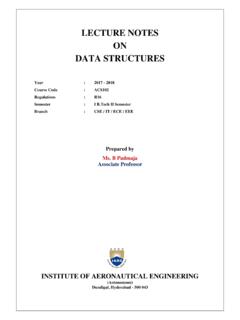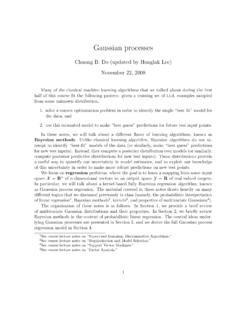Transcription of LECTURE NOTES ON DATA PREPARATION AND ANALYSIS …
1 LECTURE NOTES ON DATA PREPARATION AND ANALYSIS (BCSB13) Prepared by, G. Sulakshana, Assistant Professor, CSE Dept. DEPARTMENT OF COMPUTER SCIENCE AND ENGINEERING INSTITUTE OF AERONAUTICAL ENGINEERING (Autonomous) Dundigal, Hyderabad- 500043 MODULE -I DATA GATHERING AND PREPARATION BIG DATA ANALYTICS: The volume of data that one has to deal has exploded to unimaginable levels in the past decade, and at the same time, the price of data storage has systematically reduced. Private companies and research institutions capture terabytes of data about their users interactions, business, social media, and also sensors from devices such as mobile phones and automobiles.
2 The challenge of this era is to make sense of this sea of data. This is where big data analytics comes into picture. Big Data Analytics largely involves collecting data from different sources, mange it in a way that it becomes available to be consumed by analysts and finally deliver data products useful to the organization business. Big Data Analytics - Data Life Cycle: Traditional Data Mining Life Cycle: In order to provide a framework to organize the work needed by an organization and deliver clear insights from Big Data, it s useful to think of it as a cycle with different stages.
3 It is by no means linear, meaning all the stages are related with each other. This cycle has superficial similarities with the more traditional data mining cycle as described in CRISP methodology. CRISP-DM Methodology: The CRISP-DM methodology that stands for Cross Industry Standard Process for Data Mining is a cycle that describes commonly used approaches that data mining experts use to tackle problems in traditional BI data mining. It is still being used in traditional BI data mining teams. Take a look at the following illustration. It shows the major stages of the cycle as described by the CRISP-DM methodology and how they are interrelated.
4 CRISP-DM was conceived in 1996 and the next year, it got underway as a European Union project under the ESPRIT funding initiative. The project was led by five companies: SPSS, Terradata, Daimler AG, NCR Corporation, and OHRA (an insurance company). The project was finally incorporated into SPSS. The methodology is extremely detailed oriented in how a data mining project should be specified. Let us now learn a little more on each of the stages involved in the CRISP-DM life cycle Business Understanding This initial phase focuses on understanding the project objectives and requirements from a business perspective, and then converting this knowledge into a data mining problem definition.
5 A preliminary plan is designed to achieve the objectives. A decision model, especially one built using the Decision Model and Notation standard can be used. Data Understanding The data understanding phase starts with an initial data collection and proceeds with activities in order to get familiar with the data, to identify data quality problems, to discover first insights into the data, or to detect interesting subsets to form hypotheses for hidden information. Data PREPARATION The data PREPARATION phase covers all activities to construct the final dataset (data that will be fed into the modeling tool(s)) from the initial raw data.
6 Data PREPARATION tasks are likely to be performed multiple times, and not in any prescribed order. Tasks include table, record, and attribute selection as well as transformation and cleaning of data for modeling tools. Modeling In this phase, various modeling techniques are selected and applied and their parameters are calibrated to optimal values. Typically, there are several techniques for the same data mining problem type. Some techniques have specific requirements on the form of data. Therefore, it is often required to step back to the data PREPARATION phase. Evaluation At this stage in the project, you have built a model (or models) that appears to have high quality, from a data ANALYSIS perspective.
7 Before proceeding to final deployment of the model, it is important to evaluate the model thoroughly and review the steps executed to construct the model, to be certain it properly achieves the business objectives. A key objective is to determine if there is some important business issue that has not been sufficiently considered. At the end of this phase, a decision on the use of the data mining results should be reached. Deployment Creation of the model is generally not the end of the project. Even if the purpose of the model is to increase knowledge of the data, the knowledge gained will need to be organized and presented in a way that is useful to the customer.
8 Depending on the requirements, the deployment phase can be as simple as generating a report or as complex as implementing a repeatable data scoring ( segment allocation) or data mining process. In many cases, it will be the customer, not the data analyst, who will carry out the deployment steps. Even if the analyst deploys the model, it is important for the customer to understand upfront the actions which will need to be carried out in order to actually make use of the created models. SEMMA Methodology: SEMMA is another methodology developed by SAS for data mining modeling. It stands for Sample, Explore, Modify, Model, and Asses.
9 Here is a brief description of its stages Sample The process starts with data sampling, , selecting the dataset for modeling. The dataset should be large enough to contain sufficient information to retrieve, yet small enough to be used efficiently. This phase also deals with data partitioning. Explore This phase covers the understanding of the data by discovering anticipated and unanticipated relationships between the variables, and also abnormalities, with the help of data visualization. Modify The Modify phase contains methods to select, create and transform variables in PREPARATION for data modeling.
10 Model In the Model phase, the focus is on applying various modeling (data mining) techniques on the prepared variables in order to create models that possibly provide the desired outcome. Assess The evaluation of the modeling results shows the reliability and usefulness of the created models. The main difference between CRISM DM and SEMMA is that SEMMA focuses on the modeling aspect, whereas CRISP-DM gives more importance to stages of the cycle prior to modeling such as understanding the business problem to be solved, understanding and preprocessing the data to be used as input, for example, machine learning algorithms.
















